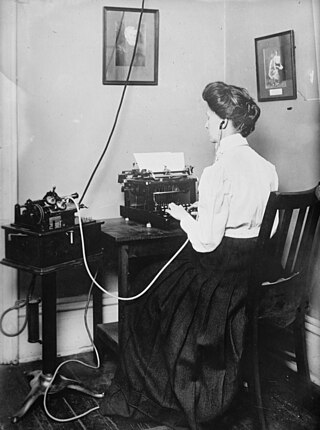
Magnetic tape is a medium for magnetic storage made of a thin, magnetizable coating on a long, narrow strip of plastic film. It was developed in Germany in 1928, based on the earlier magnetic wire recording from Denmark. Devices that use magnetic tape could with relative ease record and playback audio, visual, and binary computer data.

DV is a family of codecs and tape formats used for storing digital video, launched in 1995 by a consortium of video camera manufacturers led by Sony and Panasonic. It includes the recording or cassette formats DV, MiniDV, DVCAM, Digital8, HDV, DVCPro, DVCPro50 and DVCProHD. DV has been used primarily for video recording with camcorders in the amateur and professional sectors.

The Compact Cassette, also commonly called a cassette tape, audio cassette, or simply tape or cassette, is an analog magnetic tape recording format for audio recording and playback. Invented by Lou Ottens and his team at the Dutch company Philips and released in August 1963, Compact Cassettes come in two forms, either containing content as a prerecorded cassette (Musicassette), or as a fully recordable "blank" cassette. Both forms have two sides and are reversible by the user. Although other tape cassette formats have also existed—for example the Microcassette—the generic term cassette tape is normally used to refer to the Compact Cassette because of its ubiquity.

Digital Audio Tape is a signal recording and playback medium developed by Sony and introduced in 1987. In appearance it is similar to a Compact Cassette, using 3.81 mm / 0.15" magnetic tape enclosed in a protective shell, but is roughly half the size at 73 mm × 54 mm × 10.5 mm. The recording is digital rather than analog. DAT can record at sampling rates equal to, as well as higher and lower than a CD at 16 bits quantization. If a comparable digital source is copied without returning to the analogue domain, then the DAT will produce an exact clone, unlike other digital media such as Digital Compact Cassette or non-Hi-MD MiniDisc, both of which use a lossy data-reduction system.

Dictaphone was an American company founded by Alexander Graham Bell that produced dictation machines. It is now a division of Nuance Communications, based in Burlington, Massachusetts.

The Microcassette is an audio storage medium, introduced by Olympus in 1969.

The 8mm video format refers informally to three related videocassette formats. These are the original Video8 format and its improved successor Hi8, as well as a more recent digital recording format known as Digital8. Their user base consisted mainly of amateur camcorder users, although they also saw important use in the professional television production field.

MicroMV is a proprietary videotape format introduced in October 2001 by Sony. It is the smallest videotape format — 70% smaller than MiniDV or about the size of two US quarter coins; it is also smaller than a Digital8 or DV cassette and slightly smaller than an audio microcassette. It was the first helical scan tape system using MR read head introduced to the market. Each cassette can hold up to 60 minutes of video.

VHS-C is the compact variant of the VHS videocassette format, introduced by Victor Company of Japan (JVC) in 1982, and used primarily for consumer-grade compact analog recording camcorders. The format is based on the same video tape as is used in VHS, and can be played back in a standard VHS VCR with an adapter. An improved version named S-VHS-C was also developed. S-VHS's main competitor was Video8; however both became obsolete in the marketplace by the digital video formats MiniDV and MiniDVD, which have smaller form factors.

NT is a digital memo recording system introduced by Sony in 1992.

PlayTape is a 1⁄8 inch (3.2 mm) audiotape format and mono or stereo playback system introduced in 1966 by Frank Stanton. It is a two-track system, and was launched to compete with existing 4-track cartridge technology. The cartridges play anywhere from eight to 24 minutes, and are continuous. Because of its portability, PlayTape was an almost instant success, and over 3,000 artists had published in this format by 1968. White cases usually meant about eight songs were on the tape.
The Mini-Cassette, often written minicassette, is a magnetic tape audio cassette format introduced by Philips in 1967.
Since the widespread adoption of reel-to-reel audio tape recording in the 1950s, audio tapes and tape cassettes have been available in many formats. This article describes the length, tape thickness and playing times of some of the most common ones.

A dictation machine is a sound recording device most commonly used to record speech for playback or to be typed into print. It includes digital voice recorders and tape recorder.

The Steno-Cassette is an analog cassette format for dictation, introduced by Grundig in 1971. It gained widespread use in Germany, where it was established as a DIN standard in 1985. It is easily distinguished from other dictation cassette formats by the integrated tape counter index, showing the amount of tape available.
Grundig Business Systems (GBS) is a German company located in Bayreuth and Nuremberg in Germany and employs 170 people. Since 2001, it has been an independent corporation that manufactures analogue and digital dictation devices featuring the "Made in Germany" label.
An audio typist is someone who specialises in typing text from an audio source which they listen to. The source, or original document is usually recorded onto microcassettes created by someone dictating into a Dictaphone. The audio typist will have learnt to touch type at a high speed which means they can look at the monitor or keep an eye on a waiting area as they are typing because they do not need to look at the keyboard. A specialist player called a micro cassette transcriber (below) is used for playback of the cassettes to maximise the typing speed.
HiPac, is an audio tape cartridge format, introduced in August 1971 on the Japanese consumer market by Pioneer and discontinued in 1973 due to lack of demand. In 1972 it only achieved a market share of 3% in equipping new cars. In the mid 1970s, the format was repurposed as a children's educational toy called ポンキー and was used in the analog tape delay "Melos Echo Chamber".

IBM Electric Typewriter Division manufactured and sold dictation equipment from 1960 until 1982. This was a totally new product area for IBM who had no previous experience in this field. The Typewriter Division entered the market to meet Thomas J. Watson Jr.'s goal to double their business size every five years, which given their dominance in the electric typewriter market, meant they needed to offer a wider variety of product types. IBMs goal with dictation machines was to provide efficient, easy to use products that offered high audio fidelity. However while dictation machines were complementary with IBMs typewriter product range, it did require IBMs Sales reps to learn how to sell a totally different product. This was because many executives were reluctant to use dictation machines. IBM was the market leader by 1965, outselling their biggest competitor Dictaphone and driving Ediphone out of the market. Unit sales peaked in 1969 at 98,000 units, which was roughly a 33% market share.













